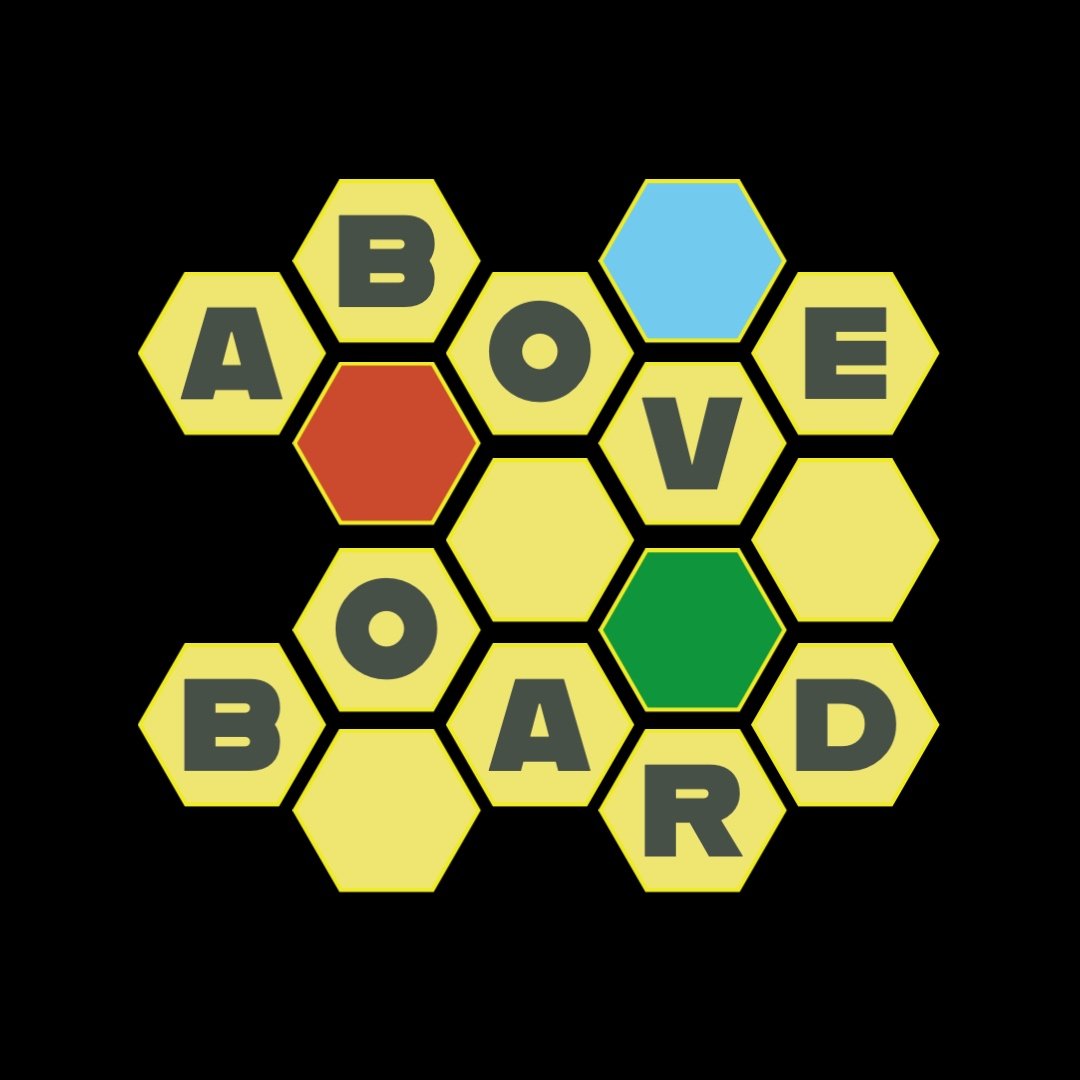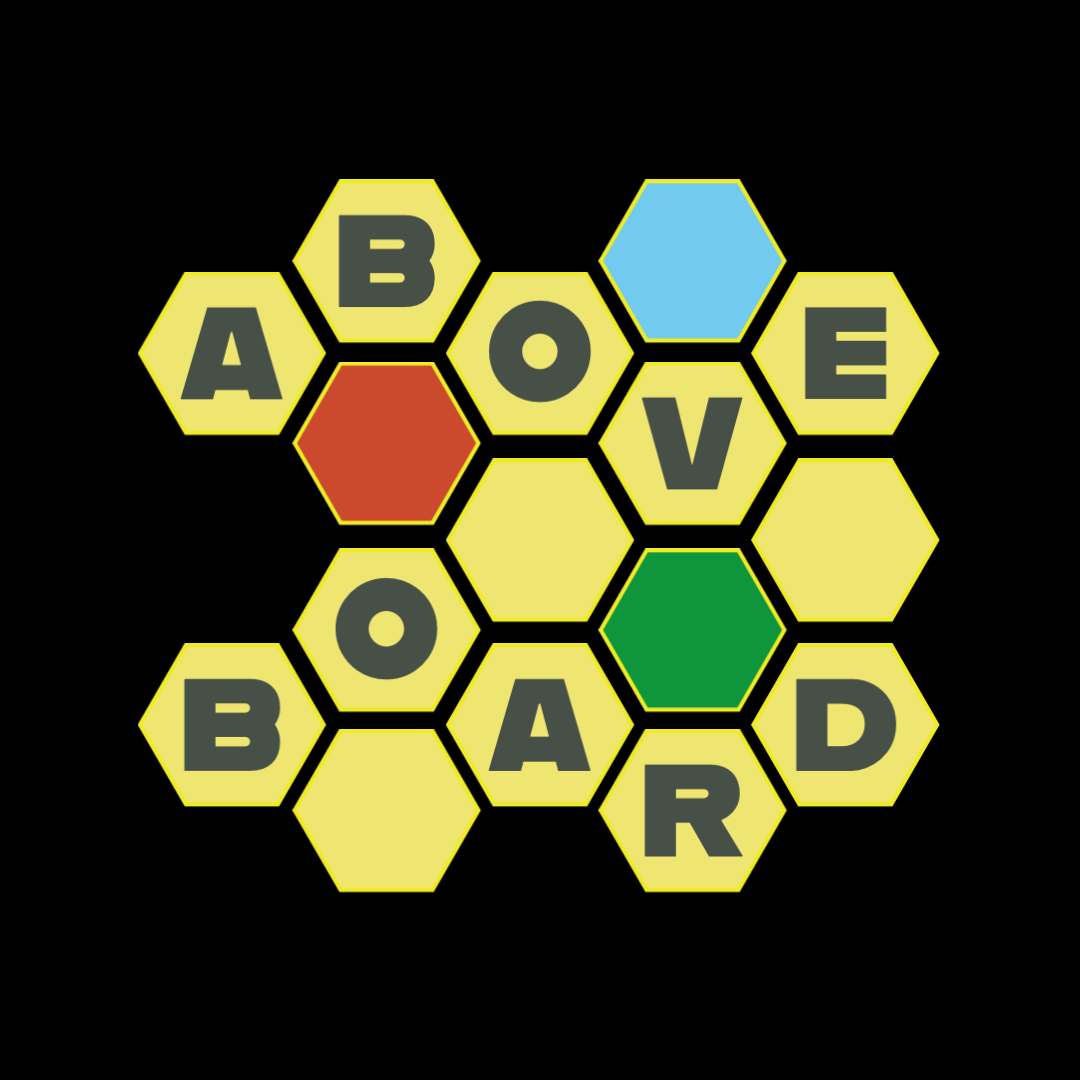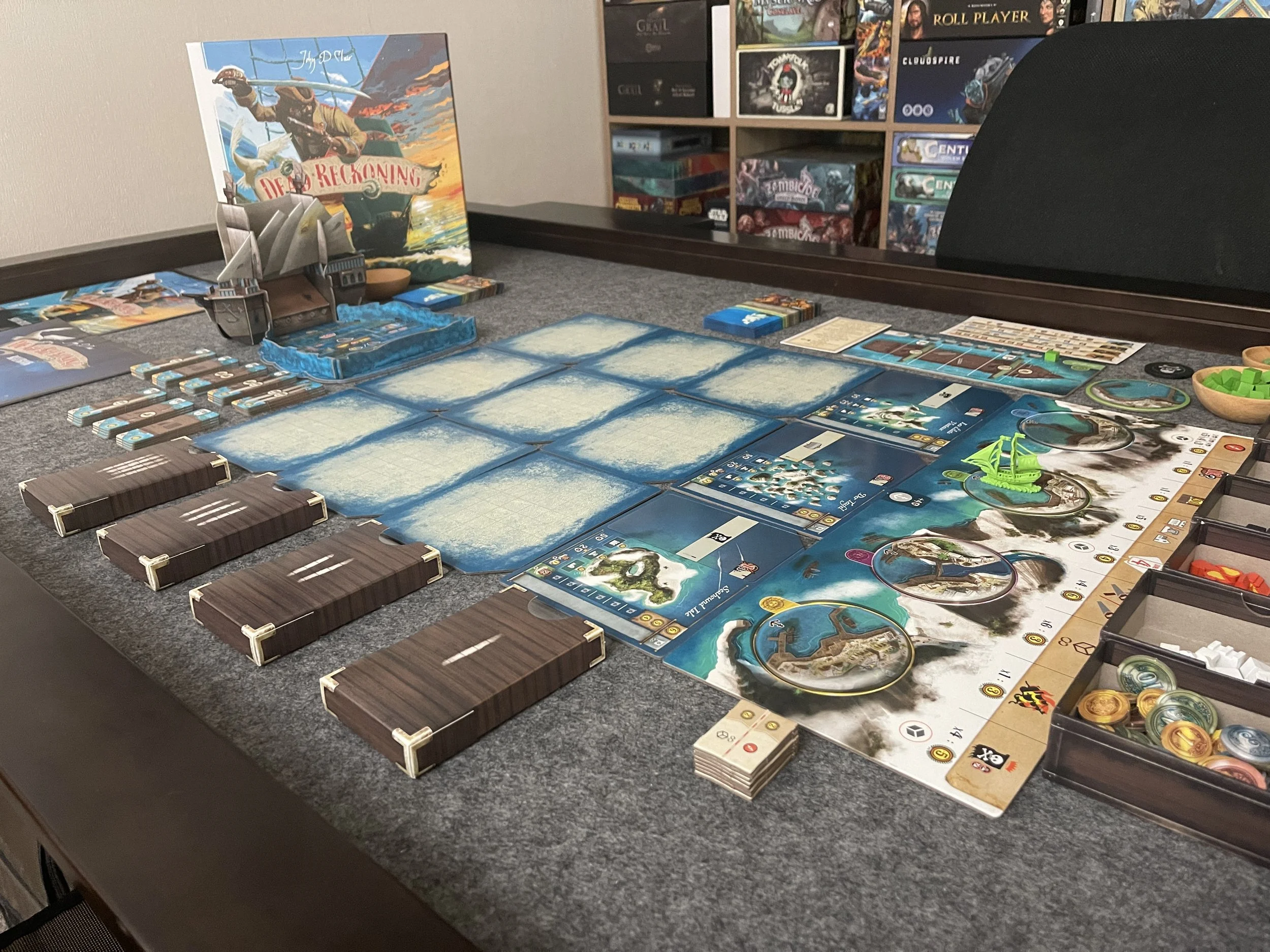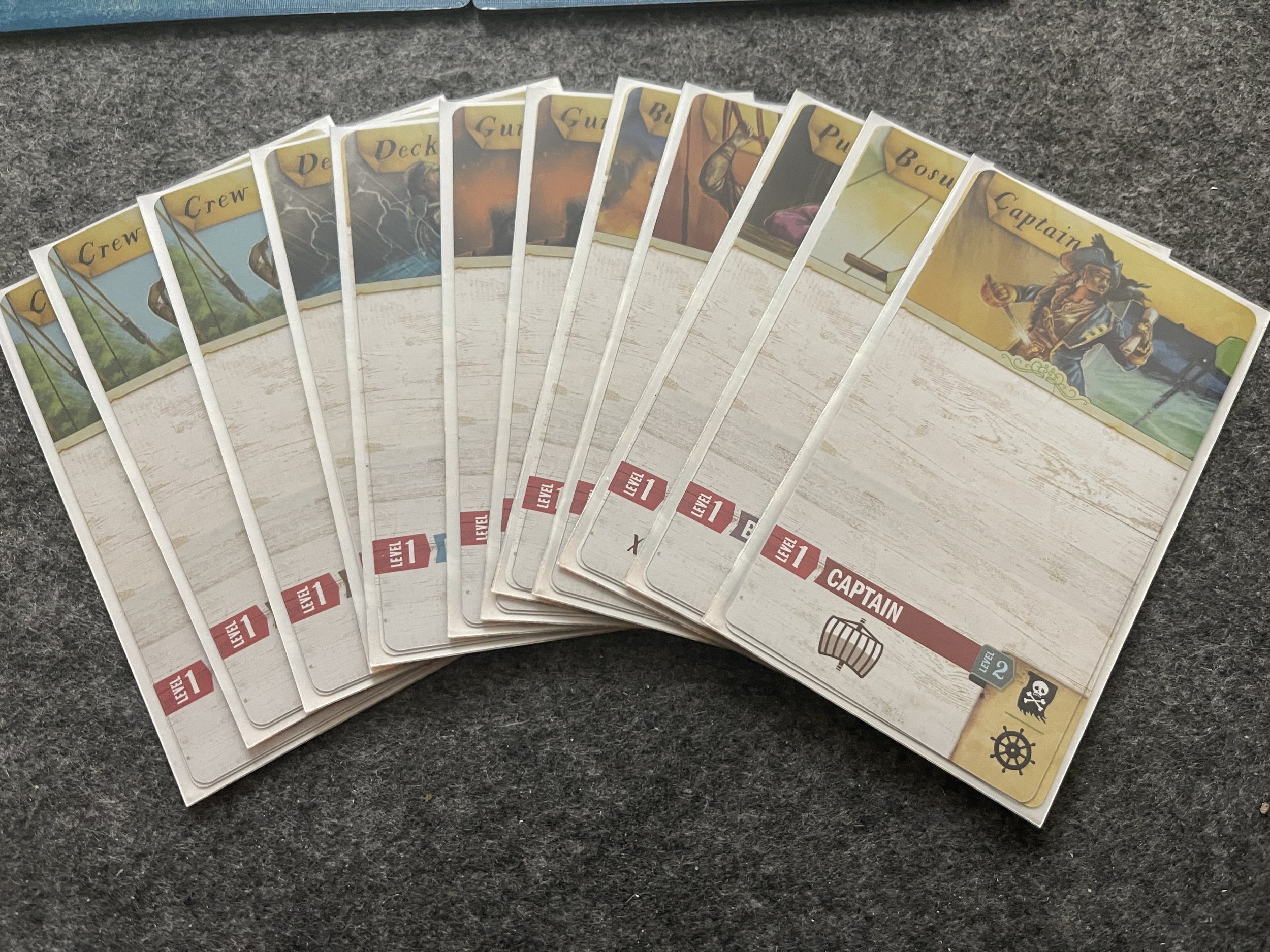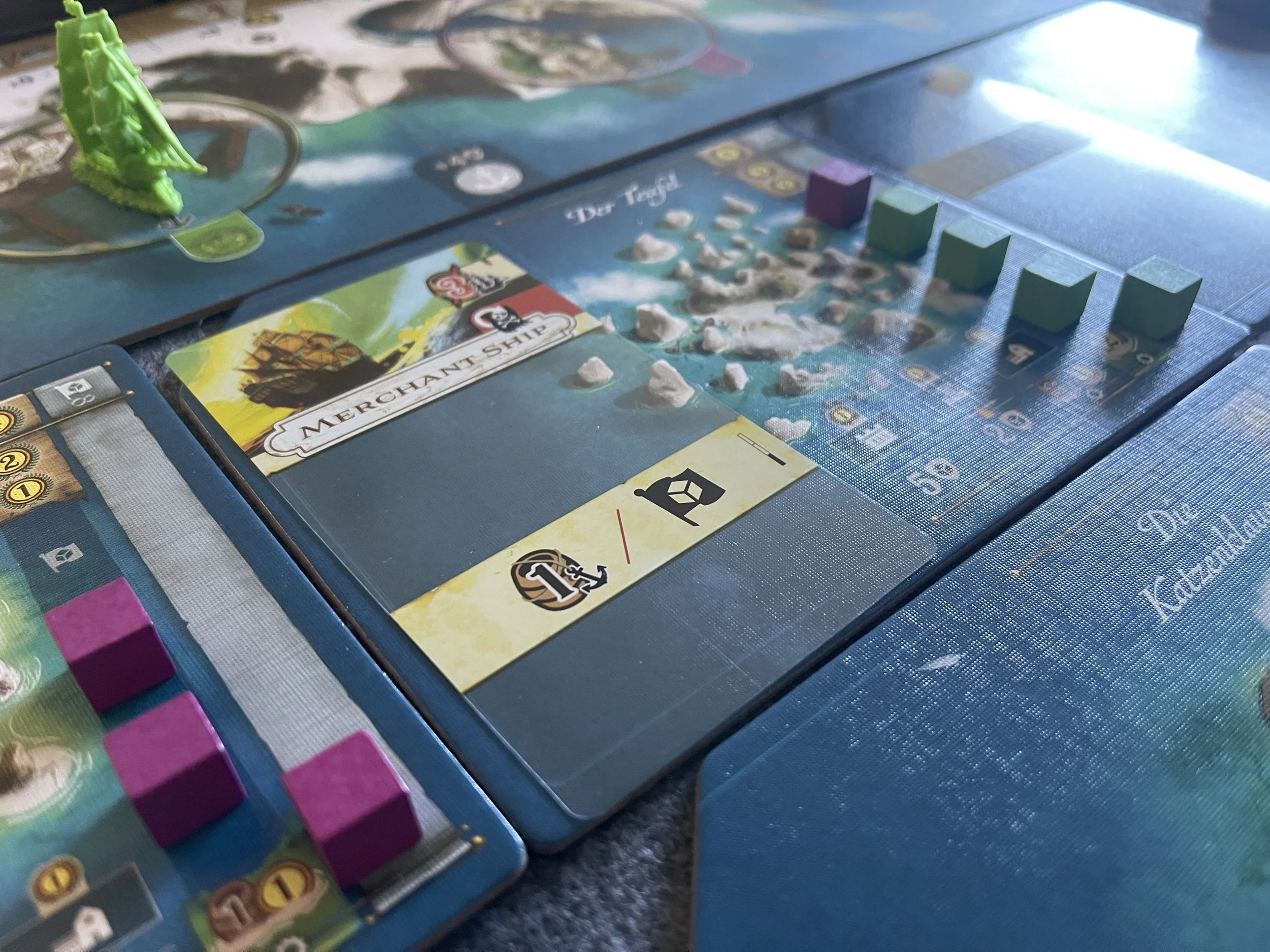Dead Reckoning Review
Aaarrrgghh! Pirate talk! Nautical references! A vague callback to that pirate movie you watched that one time! Join me as I review Dead Reckoning me hearties!
1-4 Players 90-150 mins Age 14+
Designer: John D. Clair
Artist: Ian O’Toole
Publisher: Alderac Entertainment Group (AEG)
Weigh Anchor and Hoist the Mizzenmast!
John D. Clair has quickly become one of my favourite game designers. His past offerings have always put fun at the forefront, and Dead Reckoning is a excellent example of this. Mystic Vale until recently has always been a personal favourite of mine, the card crafting system was utilised perfectly as the backbone to a push-your-luck deck building game set in a mystical land of druids and the fantastic denizens that inhabit their groves. The trouble with that was, the theme was a little flakey. I knew I was a Druid protecting his grove and trying to hold off the decay that threatened the world, but to be honest, I really didn’t care much about all that. I just wanted to craft powerful cards and chain epic combinations to win fantasy points! Make no mistake, it’s still one of my top rated games of all time and one I’ll return to time and again. However, as a game, I feel Dead Reckoning does Mystic Vale better and more fun. It’s clear from the very early stages of the game who I’m supposed to be, and what I’m supposed to do. I’m a privateer, a merchant, a pirate, an adventurer and I’m supposed to set sail to discover and control islands, collect treasure, trade cargo, engage in ship to ship battles with a vessel I can upgrade, and best of all, I use card crafting to improve my crew! Checks. Every. Box!
Splice the Mainbrace Ya Scallywags!
Dead Reckoning leans heavily into its theme, placing you at the helm of your own privateer vessel. You begin in your dock at the harbour then set sail to explore the ocean by revealing ocean tiles to discover islands, or perhaps vast open waters. Every space contains an advancement, a transparent card containing some manner of upgrade or skill that can be purchased with cargo on your ship in order to improve the abilities and functionality of your crew. While card crafting is marketed as the primary game mechanic, it really serves as just one among a multitude of systems that players have at their disposal. During our play through, we gained just as much value from upgrading our ship or levelling up our crew as we did from gaining advancements. I’ll touch more on levelling up later, but be assured, there is no shortage of options for gaining an edge over your competition and they all feel satisfying and powerful.
Don’t feel that given the game’s pirate theme that this is the only life for you. It’s entirely possible to play the game more passively, although at the expense of some missed opportunities perhaps. Remaining a merchant or privateer can allow you to lean into the trading, building and area control aspects of the game, though that last one can lead to some aggression as players compete for control over the islands, which produce resources and contribute to endgame win conditions. While there’s no trading between players, which seems a shame, the enterprising player can trade with merchant ships that occasionally appear as advancement cards on ocean tiles, when approaching these encounters players can choose to trade by simply buying the card and obtaining the advancement shown, or, they can choose to attack the merchant ship to attempt to get a more powerful advancement on the reverse side of the merchant card. The trick here is, you won’t know how powerful the merchant ship is, what the reward or consequence of the battle will be or which more powerful advancement you’ll end up with. This hidden information makes for some tense decision making as players weigh up the capabilities of their own vessels and engage in some quick risk/reward calculations before choosing to proceed. Several times I came away from these encounters with a bloody nose, but snagged myself some worthwhile rewards for doing so. Nothing ventured, nothing gained, as they say.
Speaking of hidden information, in addition to merchant ships and the usual unpredictability of deck building and hoping you draw the cards you need, each player has a treasure chest in which they place their 15 starting coins and add their plunder whenever they can safely return their treasures to port and transfer the coins to their chests. The amount of gold gained is kept hidden from other players and the only indication that someone is doing well for themselves is when, at some point, they suddenly place their flag on the 30 Coins achievement at the top of the board indicating that have secured at least that many coins, beyond that, until you score your final tallies at the end of the game, you often wont have a clue who’s going to take home the win.
Last but not least is the combat system. Rather than simply rolling dice or comparing numbers on a sheet, players instead drop cubes into the 3D pirate ship, which I’ve come to refer to as the drop-ship. The tray at the base of the ship contains a dual layered board with various spaces for damage, victory points, plunder etc. The number of cubes dropped depends on the combat abilities of your ship and crew. More isn’t always better either as you increase the chances of landing on less favourable spaces as much as the positive ones, though the nasty spaces are smaller and less likely to be hit. Whichever side secured the most victory points, represented by the crown icon, wins the combat. After the battle, any damage is assigned, plunder is collected, if applicable and the game proceeds. If however, a player’s ship takes a cumulative total of five damage, it’s sunk! This results in the sunk player paying their opponent 5 coins, from their ship if possible, but any shortfall comes straight out of their secret chest. All damage is then removed from their ship, they return to port, still with any cargo they were carrying, and their sails are set to zero for the remainder of their turn. After which they’ll be free to continue adventuring as normal. Not the most punishing result, but anything more risks the players enjoyment and would result in everyone going out of their way to avoid battle at all costs, so I feel like this is a fair compromise that encourage players to get stuck in and enjoy the game for what it is without focussing needlessly on preserving their ship.
Yo Ho Ho!
Dead Reckoning creates a wonderful sense of adventure and exploration on the high seas. The emergent strategies that unfold throughout gameplay encourage players to try new thing and experiment with the game’s toy box. Nothing is more satisfying than developing a course of action over several turns and then having it pay off when the right conditions finally align. Even if things don’t go as planned, the system is flexible and forgiving enough for players to course correct without falling far behind.
Battles can be unpredictable and turn on a whim regardless of how many cubes you’re dropping. There were a number of situations in which a player won a battle, even though their ship was sunk and their opponent walked away largely unscathed. Such is glory I suppose. Thematically it may not make a whole lot of sense, but within the confines of a game in which fun is at the forefront, it works well, giving even underdogs the chance to bare their fangs and come out on top.
I’ve said before that the sign of a good game is if you can strip away the theme and the game still holds up well then it’s probably a pretty solid design. However, the opposite can be true too. Do the mechanisms of the game serve the theme? In Dead Reckoning’s case, the answer is a hearty, yes! Flipping tiles to explore unknown waters, upgrading your ship tiles to improve your sails, cannons and holds, levelling up and adding advancements to your crew as they grow in strength and experience and the bombastic chaos of combat as two ships broadside one another with everything including the kitchen sink, these are just a few of the many ways John D. Clair has managed to convey the pirate theme so effectively. Even down to the hidden information of the chests and merchant ships; secrets, and the thrill of the unknown as you venture forth to make your fortune and rule the seas!
You Landlubbers Lookin’ to Hornswaggle Me?
There are very few downsides to Dead Reckoning, and most of them come down to things that are largely beyond the player’s control. The first is there are three separate ‘improvement’ mechanisms in the game, and they each function differently and at different times. While each one makes sense, upgrading your ship, levelling up your crew and adding advancements; each one of these has its own method and timing within the game’s structure which can be confusing when first learning the game. For example, during your turn you can only buy ship upgrades if you have levelled up your Bosun crew member to at least level 3 (of 4 possible levels for each sailor). You can purchase the upgrade whenever you play a sufficiently upgraded Bosun by spending resources from either your harbour, an island with resources that you control or from your ship. Levelling up your crew however, only happens between your turns on newly drawn cards before your next turn, whereas adding advancements to a card happens at the end of your current turn to a card you played that turn, or you can hold one advancement in reserve until the end of your next turn in case you’re waiting or hoping for a particular crewman to show themselves. Each of these systems makes sense in context and once players have learned the round structure and where everything fits this will soon become second nature, but it can take some backtracking until it clicks.
Another sticking point for some players is that combat feels too random and unfair. While the people I played with appeared to enjoy it, others I’ve heard of find the randomness to be a bit much. So if that kind of approach bothers you, you might want to be aware. For myself, I embraced the chaos and it was glorious! Even when a battle didn’t go my way, I had a great time finalising the outcome.
Shiver Me Timbers!
As for the art and components, I can best describe Dead Reckoning as clean. What I mean by that is all the artwork looks crisp, clear and intuitive. Bold iconography across all the cards, players boards and tiles with handy reference cards for each player helps to get a handle on the round structure. The rule book does its job well and the layout made sense, gradually unfolding each stage of the game and giving each newly introduced concept room to breathe. The game comes with plastic barrels representing the cargo, wooden screen printed damage tokens and gorgeously illustrated card sleeves for the all important card crafting, but I would have liked to see more spare sleeves included in the box as wear and tear is a genuine concern when components are handled with this much frequency.
Ian O’Toole is the artist behind the curtain here and he’s done a fantastic job with the character designs as each sailor feels distinctive and recognisable. The 3D ship makes for an eye catching centrepiece, but doesn’t detract from the main play area where the blues and whites of the ocean tiles draw the player’s eyes towards the action where they should be.
My only other concern beyond the lack of extra card sleeves is the design of the treasure chests, these serve not only as a playing piece to keep player gold hidden, but as storage containers for each player’s components between games. This little box is going to see a lot of use, frequently being opened and closed and yet the designers made the odd decision to have the lid tuck into the box. This makes opening the box more fiddly than it ought to be and again, raises concerns around the durability of the component. A more traditional magnetically sealing box with the flap on the outside would have tended to all these concerns. Perhaps there was a budgetary reason for this, but as Dead Reckoning was already a Kickstarter exclusive release, I’m sure backers would have been happy to see this change even if it cost them an extra doubloon or two.
Aaaaarrrrrggggghhhhh!
As it stands, Dead Reckoning is a thoroughly satisfying romp, the sense of adventure and exploration is high with a lot to see and experience. Card crafting is always a winner for me and it feels even more satisfying when coupled with a very clear theme as it is here. Dead Reckoning provides a surprisingly deep, strategic and above all, immensely enjoyable time. It’s a shame AEG restricted this to Kickstarter as it really does possess mainstream appeal and I think it could have done well at retail even if they had to cut a few component corners to get it there, but if you can pick one up someplace, then I highly recommend it. (At the time of this writing Gameology in Australia still had a copy in stock, that’s where I managed to snag mine!) However you manage to track one down, I don’t think you’ll regret it, Dead Reckoning has found a permanent place in my collection.
As always, thanks for reading and I hope you enjoyed the review. Have you managed to play Dead Reckoning? Or is there another title by John D. Clair you would recommend? Let us know by commenting below, or tell us over on our Above Board Facebook group where you can keep up to date with our latest content. See you next time ya landlubbers!
